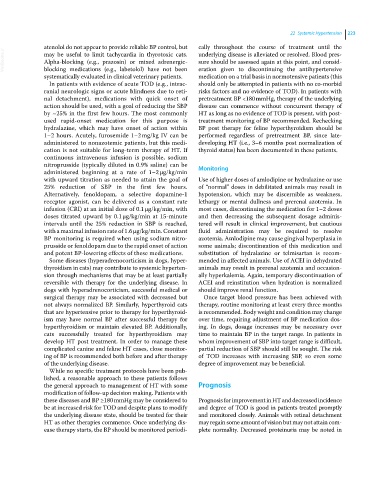Page 255 - Clinical Small Animal Internal Medicine
P. 255
22 Systemic Hypertension 223
atenolol do not appear to provide reliable BP control, but cally throughout the course of treatment until the
VetBooks.ir may be useful to limit tachycardia in thyrotoxic cats. underlying disease is alleviated or resolved. Blood pres-
sure should be assessed again at this point, and consid-
Alpha‐blocking (e.g., prazosin) or mixed adrenergic‐
blocking medications (e.g., labetolol) have not been
medication on a trial basis in normotensive patients (this
systematically evaluated in clinical veterinary patients. eration given to discontinuing the antihypertensive
In patients with evidence of acute TOD (e.g., intrac- should only be attempted in patients with no co‐morbid
ranial neurologic signs or acute blindness due to reti- risks factors and no evidence of TOD). In patients with
nal detachment), medications with quick onset of pretreatment BP <180 mmHg, therapy of the underlying
action should be used, with a goal of reducing the SBP disease can commence without concurrent therapy of
by ~25% in the first few hours. The most commonly HT as long as no evidence of TOD is present, with post-
used rapid‐onset medication for this purpose is treatment monitoring of BP recommended. Rechecking
hydralazine, which may have onset of action within BP post therapy for feline hyperthyroidism should be
1–2 hours. Acutely, furosemide 1–2 mg/kg IV can be performed regardless of pretreatment BP, since late‐
administered to nonazotemic patients, but this medi- developing HT (i.e., 3–6 months post normalization of
cation is not suitable for long‐term therapy of HT. If thyroid status) has been documented in these patients.
continuous intravenous infusion is possible, sodium
nitroprusside (typically diluted in 0.9% saline) can be Monitoring
administered beginning at a rate of 1–2 μg/kg/min
with upward titration as needed to attain the goal of Use of higher doses of amlodipine or hydralazine or use
25% reduction of SBP in the first few hours. of “normal” doses in debilitated animals may result in
Alternatively, fenoldopam, a selective dopamine‐1 hypotension, which may be discernible as weakness,
receptor agonist, can be delivered as a constant rate lethargy or mental dullness and prerenal azotemia. In
infusion (CRI) at an initial dose of 0.1 μg/kg/min, with most cases, discontinuing the medication for 1–2 doses
doses titrated upward by 0.1 μg/kg/min at 15‐minute and then decreasing the subsequent dosage adminis-
intervals until the 25% reduction in SBP is reached, tered will result in clinical improvement, but cautious
with a maximal infusion rate of 1.6 μg/kg/min. Constant fluid administration may be required to resolve
BP monitoring is required when using sodium nitro- azotemia. Amlodipine may cause gingival hyperplasia in
prusside or fenoldopam due to the rapid onset of action some animals; discontinuation of this medication and
and potent BP‐lowering effects of these medications. substitution of hydralazine or telmisartan is recom-
Some diseases (hyperadrenocorticism in dogs, hyper- mended in affected animals. Use of ACEI in dehydrated
thyroidism in cats) may contribute to systemic hyperten- animals may result in prerenal azotemia and occasion-
sion through mechanisms that may be at least partially ally hyperkalemia. Again, temporary discontinuation of
reversible with therapy for the underlying disease. In ACEI and reinstitution when hydration is normalized
dogs with hyperadrenocorticism, successful medical or should improve renal function.
surgical therapy may be associated with decreased but Once target blood pressure has been achieved with
not always normalized BP. Similarly, hyperthyroid cats therapy, routine monitoring at least every three months
that are hypertensive prior to therapy for hyperthyroid- is recommended. Body weight and condition may change
ism may have normal BP after successful therapy for over time, requiring adjustment of BP medication dos-
hyperthyroidism or maintain elevated BP. Additionally, ing. In dogs, dosage increases may be necessary over
cats successfully treated for hyperthyroidism may time to maintain BP in the target range. In patients in
develop HT post treatment. In order to manage these whom improvement of SBP into target range is difficult,
complicated canine and feline HT cases, close monitor- partial reduction of SBP should still be sought. The risk
ing of BP is recommended both before and after therapy of TOD increases with increasing SBP, so even some
of the underlying disease. degree of improvement may be beneficial.
While no specific treatment protocols have been pub-
lished, a reasonable approach to these patients follows
the general approach to management of HT with some Prognosis
modification of follow‐up decision making. Patients with
these diseases and BP ≥180 mmHg may be considered to Prognosis for improvement in HT and decreased incidence
be at increased risk for TOD and despite plans to modify and degree of TOD is good in patients treated promptly
the underlying disease state, should be treated for their and monitored closely. Animals with retinal detachment
HT as other therapies commence. Once underlying dis- may regain some amount of vision but may not attain com-
ease therapy starts, the BP should be monitored periodi- plete normality. Decreased proteinuria may be noted in

